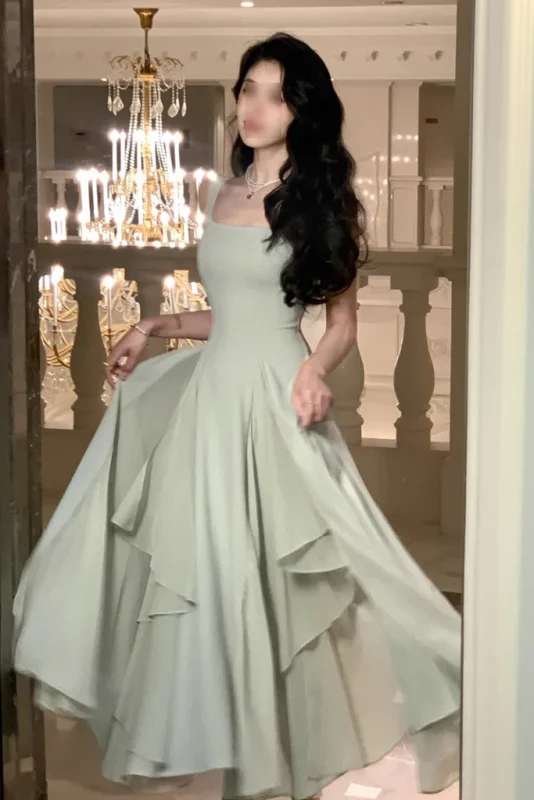Clone
What Factors Influence the Price of a Custom Dress?
We know that nothing quite matches the allure of a custom dress. Whether it’s for a wedding, gala, or a special occasion, custom prom dresses offer a level of personalization and exclusivity that off-the-rack garments simply can’t provide. However, with this uniqueness comes a range of factors that influence the price of a custom dress. Understanding these factors can help you make informed decisions and appreciate the craftsmanship behind your bespoke garment.

1. Fabric Choice
The fabric is often the most significant factor in determining the price of a custom dress. High-quality materials, such as silk, satin, lace, or handwoven textiles, are more expensive than synthetic or lower-grade fabrics. The origin and brand of the fabric can also play a role; for instance, Italian silk or French lace typically commands higher prices due to their reputation for superior quality and luxurious feel.
Key Considerations:
- Material Type: Natural fibers (silk, wool) vs. synthetic fibers (polyester, nylon).
- Source and Brand: Renowned fabric brands and origin countries.
- Amount Needed: More fabric required for elaborate designs or larger dresses.
2. Design Complexity
The intricacy of the gown design significantly impacts the price. Simple, minimalist designs require less labor and time, whereas detailed and complex patterns, like intricate beadwork, embroidery, or multi-layered silhouettes, demand more skill and hours to complete. Custom dresses that incorporate elements such as hand-sewn details, draping, or unique cuts will also contribute to higher costs.
Key Considerations:
- Detail Work: Hand beading, embroidery, lace appliqué.
- Structural Elements: Boning, layers, and special cuts.
- Unique Features: Custom prints, personalized motifs, or special requests.
3. Tailoring and Labor
The skill level and time investment of the tailor or designer are critical factors. Highly experienced or renowned designers and tailors often charge premium rates due to their expertise and reputation. The number of fittings required to achieve the perfect fit also adds to the labor cost. More intricate designs or dresses made from delicate fabrics may require additional time and precision, further influencing the price.
Key Considerations:
- Experience and Reputation: More experienced or famous designers command higher fees.
- Number of Fittings: Multiple sessions for precision fitting increase labor costs.
- Attention to Detail: Time-intensive work for complex designs.
4. Customization Level
The degree of customization also affects the price. Standard customizations, like size adjustments or color changes, might have a lower impact on cost. However, more extensive personalization, such as bespoke patterns, custom embellishments, or unique design elements tailored to the client’s preferences, can significantly raise the price. The more unique and tailored the dress, the higher the cost.
Key Considerations:
- Standard Adjustments: Basic alterations and standard size fitting.
- Extensive Personalization: Custom designs, colors, and embellishments.
- Unique Requests: One-of-a-kind patterns or details.
5. Production Timeframe
The timeline for completing the dress can also influence the cost. Rush orders that require the designer to prioritize your dress or work outside their regular schedule often come with additional fees. Conversely, a longer lead time might offer more flexibility and potentially lower costs, as the designer can schedule the work more efficiently.
Key Considerations:
- Rush Orders: Increased fees for expedited services.
- Standard Timeline: Regular scheduling allows for cost-effective production.
6. Additional Costs
There are often hidden or additional costs associated with custom dresses. These can include:
- Consultation Fees: Initial meetings with designers or consultants.
- Travel Expenses: Costs associated with attending fittings or meetings, especially if the designer is located far away.
- Accessories and Extras: Custom veils, belts, or other accessories that complement the dress.
- Alteration Services: Post-production adjustments to ensure the perfect fit.
7. Geographical Location
The geographical location of the designer or dressmaker can impact the cost. Custom dresses made in fashion capitals like New York, Paris, or Milan typically come at a premium due to higher operating costs and the prestigious market. Conversely, having a dress made in areas with a lower cost of living might reduce expenses without compromising on quality.
Key Considerations:
- Location of Designer: Higher costs in major fashion cities.
- Local Market Rates: Regional price differences in labor and materials.
When investing in a custom dress, it’s essential to consider the various factors that influence its price. From the choice of fabric and design complexity to the expertise of the tailor and the level of customization, each element plays a crucial role in determining the final cost. Understanding these factors not only helps in budgeting effectively but also deepens the appreciation for the craftsmanship and artistry involved in creating a bespoke garment.

